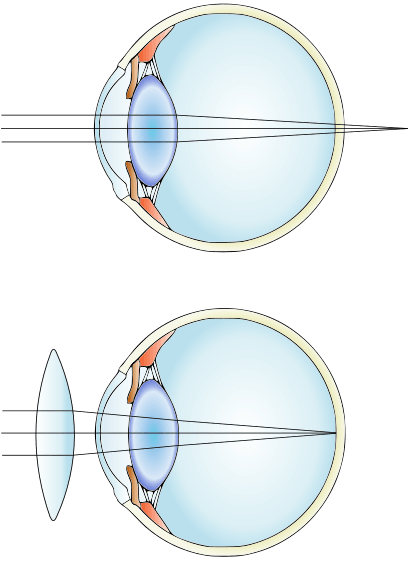Far sightedness facts for kids
Quick facts for kids Far-sightedness |
|
|---|---|
| Synonyms | Hypermetropia, hyperopia, longsightedness, long-sightedness |
 |
|
| Far-sightedness without (top) and with lens correction (bottom) | |
| Symptoms | Close objects appear blurry |
| Complications | Accommodative dysfunction, binocular dysfunction, amblyopia, strabismus |
| Causes | Too short an eyeball, misshapen lens or cornea |
| Risk factors | Family history |
| Diagnostic method | Eye exam |
| Similar conditions | Amblyopia, retrobulbar optic neuropathy, retinitis pigmentosa sine pigmento |
| Treatment | Eyeglasses, contact lenses, surgery |
| Frequency | ~7.5% (US) |
Far-sightedness, also called hyperopia, is an eye condition. It means that light focuses behind your retina instead of directly on it. This makes objects that are close to you look blurry. Things far away might still look clear.
If far-sightedness gets worse, objects at all distances can become blurry. You might also get headaches and your eyes might feel tired. Some people also have trouble with their eyes working together.
This condition happens because of a small problem with the shape of your eyes. Often, your eyeball is a bit too short. Or, the lens or cornea in your eye might not be shaped perfectly. If other family members have far-sightedness, you might be more likely to get it too. An eye exam is used to find out if you have it.
You can manage far-sightedness with eyeglasses, contact lenses, or even surgery. Glasses are usually the easiest option. Contact lenses can give you a wider view. Surgery changes the shape of your cornea. Far-sightedness is common in young children. It can also become more common again after age 40.
Contents
What are the Signs of Far-sightedness?
The main signs of far-sightedness are blurry vision, headaches, and eye strain. Eye strain is a very common symptom. You might also find it hard for both your eyes to work together. This can make it tricky to judge how far away things are.
Possible Complications
Sometimes, far-sightedness can lead to other eye problems. These include strabismus (crossed eyes) and amblyopia (lazy eye). In young children, severe far-sightedness can sometimes cause double vision. This happens because their eyes try too hard to focus.
Why Do People Get Far-sightedness?
Far-sightedness happens when the image you see focuses behind your retina. There are two main reasons for this:
- Your eye lens might not be strong enough to focus light correctly. This can happen if the ciliary muscles around it are weak.
- The cornea, which is the clear front part of your eye, might have an unusual shape.
Often, people are born with far-sightedness. However, children's eye lenses are very flexible. This helps them to adjust and see clearly. In rare cases, far-sightedness can be linked to conditions like diabetes. It can also be caused by problems with the blood vessels in the retina.
How is Far-sightedness Treated?
You can treat far-sightedness in a few ways. The goal is to help light focus correctly on your retina.
Corrective Lenses
The simplest way to treat far-sightedness is by using corrective lenses. These are either eyeglasses or contact lenses. Glasses for far-sightedness have convex lenses. These lenses help to bend light more, so it focuses on your retina.
Surgery
There are also surgical options to correct far-sightedness:
- Photorefractive keratectomy (PRK): This surgery removes a tiny bit of the surface of your cornea.
- Laser assisted in situ keratomileusis (LASIK): This is a type of laser eye surgery. It reshapes your cornea so you might not need glasses or contact lenses anymore.
- Refractive lens exchange (RLE): This surgery is similar to cataract surgery. A doctor replaces your natural crystalline lens with an artificial one. It's used when there's a big focusing problem.
- Laser epithelial keratomileusis (LASEK): This surgery is like PRK. It uses alcohol to gently loosen the surface of the cornea.
Images for kids
See also
 In Spanish: Hipermetropía para niños
In Spanish: Hipermetropía para niños




